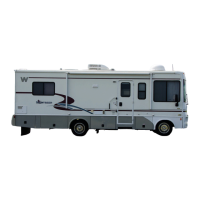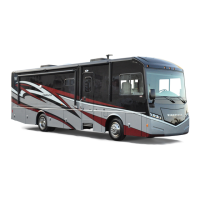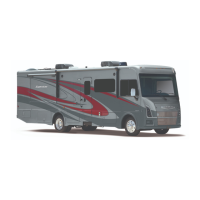Do you have a question about the Winnebago Sightseer 26P and is the answer not in the manual?
Overview of the manual's purpose, content, and safety message conventions.
Explains safety alert symbols (Danger, Warning, Caution, Note) for user safety and vehicle protection.
Details the information on the vehicle certification label, including VIN, weight ratings, and tire specifications.
Lists key dimensions, capacities (water, propane, fuel), and weight ratings for different models.
Outlines the terms, conditions, and coverage period of the new vehicle limited warranty.
Essential safety guidelines for motor home operation, covering seat belts, child restraints, and emergency exits.
Critical advice for safe driving, including seat adjustment, handling slippery conditions, and slideout extension avoidance.
Safety precautions for handling fuel and propane gas, emphasizing fire prevention and avoiding hazards.
Procedures for detecting and responding to propane gas leaks, including actions if gas is smelled.
Advises on preventing carbon monoxide exposure from exhaust and recommends exhaust system inspection.
Explains the function and maintenance of the smoke alarm, including replacement schedules for safety.
Describes the location and proper use of the fire extinguisher, emphasizing regular charge and condition checks.
Highlights electrical safety, warning against handling components with wet hands or bare feet and ensuring proper grounding.
Details operation of emergency exits like escape windows, with a caution regarding broken glass.
Guidance on handling roadside emergencies, especially tire changes, recommending professional assistance.
Explains adjustment and swiveling of driver and co-pilot seats for comfort and usability.
Details correct usage, adjustment, and fastening of seat belts for driver and passenger safety.
Provides guidelines for selecting, installing, and securely using child restraint systems in the vehicle.
Describes operation and adjustment of power electric mirrors, including mirror heaters for defogging.
Explains the safety feature preventing shifting from Park unless ignition is on and brake is pressed.
Details operation of the foot-pedal parking brake on Ford and Workhorse chassis models.
Explains the Grade Brake feature on heavier chassis for controlling downhill speed and reducing brake wear.
Describes the Tow/Haul mode for Ford chassis, optimizing transmission performance during towing.
Covers controls for the dash-mounted A/C, heating, and defroster system.
Essential information on checking and maintaining the engine cooling system, including coolant type and level.
Advises on proper suspension alignment and tire balance for vehicle handling and tire wear.
Explains refrigerator operation on 120-Volt AC electric or propane gas, and leveling requirements.
Details operation of propane gas range/oven, including lighting and safety precautions.
Describes the panel for checking fresh water, propane levels, and battery status, and operating pump/water heater.
Covers gas water heater operation, startup procedures, and troubleshooting for pilot out situations.
Explains dual-power operation of the gas/electric water heater, including quick recovery heating.
Provides instructions for starting and operating the propane gas furnace for coach heating.
Describes the heat pump system's operation for heating and cooling using electricity.
Explains thermostat control of the ducted roof A/C system for cooling the coach.
Details the EMS for managing electrical loads, preventing breaker tripping, especially with multiple AC units.
Explains the propane system's function, components, and safe handling practices for appliances.
Emphasizes critical safety measures for propane system use, including filling and leak detection.
Lists essential warnings and precautions for safe propane gas usage, covering leaks, refueling, and ventilation.
Describes the regulator's function and maintenance, including visual inspection for blockages.
Stresses dangers of electrical shock and provides safety warnings for handling electrical components.
Details the 120-volt AC system operation, powered by shoreline/generator, and its conversion to 12-volt DC.
Explains external power cord connection and use, emphasizing proper grounding and polarity verification.
Describes the power center housing circuit breakers and fuses for 120-volt AC and 12-volt DC systems.
Explains GFCI outlet protection against electrical shock and how to reset them.
Covers generator operation and safety precautions, including its hourmeter and oil level check.
Details the 12-volt DC system powered by batteries, including the converter and battery types.
Explains the AUX BATT switch function for preventing battery drain during storage periods.
Provides guidance on maintaining lead-acid batteries, including preventing sulfation and checking fluid levels.
Describes the fresh water system, sources, and how to fill the fresh water tank.
Explains connecting to and using external city water, bypassing the onboard pump and tank.
Details the demand water pump operation, supplying water from the fresh water tank when a faucet is opened.
Provides a procedure for disinfecting the potable water system, recommended for new or stored systems.
Offers instructions for RV toilet use, including important "don'ts" to prevent damage and clogs.
Explains the water heater bypass valve's function, especially for winterization procedures.
Outlines methods for winterizing the plumbing system (blow-out, antifreeze fill) to prevent freeze damage.
Guides basic operation of the A/V system, including TV and DVD player setup.
Details DVD player connection and operation, including disc insertion and playback selection.
Explains how to raise, rotate, and lower the TV antenna for optimal signal reception.
Describes the TV signal amplifier's function and performance checks for clear TV reception.
Identifies the location of the cable TV connector for external hookups.
Notes the coach is pre-wired for digital satellite TV, with connection locations specified.
Describes exterior entertainment center features, including stereo, outlets, and TV hookup.
Explains operation of the swivel glider chair, including glide-lock and base clamp mechanisms.
Provides safety warnings regarding the use of sleeping facilities while the vehicle is in motion.
Details the process for converting the sofa into a bed and vice versa.
Describes converting the dinette seating area into a bed and back into a dinette.
Explains operation of pleated blinds for light filtering, room darkening, and privacy.
Discusses wood types, finishes, natural characteristics, and aging of cabinetry.
Explains the slideout room travel lock function and its engagement/release for safe transit.
Details electric slideout room operation, switch locations, and precautions before extending/retracting.
Step-by-step instructions for extending slideout rooms, emphasizing pre-operation checks and engine running.
Instructions for retracting slideout rooms, including pre-operation checks and handling roof water.
Advises retracting slideout rooms during extreme weather to prevent damage to seals and mechanisms.
Addresses electrical issues like low battery voltage or tripped breakers for slideout rooms.
Guides manual retraction of front slideout rooms via crank-in mode if electric fails.
Tips for maintaining slideout room seals and ensuring clean floors before retraction for optimal operation.
Explains the hydraulic leveling system's purpose, operation, and control panel for easier parking.
Instructs on checking hydraulic oil level for the leveling system, covering procedure and fluid type.
Stresses regular inspection and maintenance of sealants to prevent water intrusion and damage.
Discusses roof maintenance, construction, and safety precautions for working on the roof surface.
Advises cleaning the undercarriage to prevent rust and corrosion from road salt or dirt.
Guidance on preserving paint finish through proper parking, driving, and washing practices.
Tips for cleaning and maintaining exterior appliques and decals.
Guides cleaning plastic parts, recommending mild cleaners and warning against harsh solvents.
Recommends routine vacuuming of fabrics and carpets to maintain cleanliness and prolong life.
Discusses cleaning fabric upholstery, advising on product selection and testing to avoid damage.
Provides specific cleaning instructions for Ultraleather HP™ upholstery, recommending spot treatments.
Offers guidance on cleaning ceiling fabrics, including a stain removal chart.
Explains cleaning wooden and vinyl cabinetry, advising against solvents for vinyl surfaces.
Describes cleaning and maintaining tables and countertops, recommending furniture wax.
Details steps for preparing the motor home for storage, including propane shutoff, battery charging, and cleaning.
Outlines procedures for preparing the motor home after storage, covering system checks and sanitizing.
Presents a maintenance schedule for various systems, indicating recommended inspection intervals.
Crucial guidance on safely loading the vehicle, emphasizing weight distribution and securing loose items.
Explains weighing the loaded vehicle at commercial scales for proper load distribution and weight compliance.
Advice on towing vehicles or trailers, including hitch capacity, tongue weight, and brake system considerations.
Defines towing terms like GVWR/GAWR and emphasizes proper equipment and weight limits for safe towing.
Describes the electric entry step operation, including its automatic retraction feature and safety warnings.
Explains operation of various window types, including crank-out and slider windows.
Details operation of the roof ventilator, including raising the dome and adjusting fan speed.
Discusses storage compartment door gaskets and ensuring a proper seal for weather protection.
Describes the roof ladder's purpose, safety warnings, and precautions before use.
Addresses issues like humidity and condensation from extended occupancy and mitigation steps.
Explains managing humidity and condensation by ventilating and minimizing moisture sources.
Overview of the manual's purpose, content, and safety message conventions.
Explains safety alert symbols (Danger, Warning, Caution, Note) for user safety and vehicle protection.
Details the information on the vehicle certification label, including VIN, weight ratings, and tire specifications.
Lists key dimensions, capacities (water, propane, fuel), and weight ratings for different models.
Outlines the terms, conditions, and coverage period of the new vehicle limited warranty.
Essential safety guidelines for motor home operation, covering seat belts, child restraints, and emergency exits.
Critical advice for safe driving, including seat adjustment, handling slippery conditions, and slideout extension avoidance.
Safety precautions for handling fuel and propane gas, emphasizing fire prevention and avoiding hazards.
Procedures for detecting and responding to propane gas leaks, including actions if gas is smelled.
Advises on preventing carbon monoxide exposure from exhaust and recommends exhaust system inspection.
Explains the function and maintenance of the smoke alarm, including replacement schedules for safety.
Describes the location and proper use of the fire extinguisher, emphasizing regular charge and condition checks.
Highlights electrical safety, warning against handling components with wet hands or bare feet and ensuring proper grounding.
Details operation of emergency exits like escape windows, with a caution regarding broken glass.
Guidance on handling roadside emergencies, especially tire changes, recommending professional assistance.
Explains adjustment and swiveling of driver and co-pilot seats for comfort and usability.
Details correct usage, adjustment, and fastening of seat belts for driver and passenger safety.
Provides guidelines for selecting, installing, and securely using child restraint systems in the vehicle.
Describes operation and adjustment of power electric mirrors, including mirror heaters for defogging.
Explains the safety feature preventing shifting from Park unless ignition is on and brake is pressed.
Details operation of the foot-pedal parking brake on Ford and Workhorse chassis models.
Explains the Grade Brake feature on heavier chassis for controlling downhill speed and reducing brake wear.
Describes the Tow/Haul mode for Ford chassis, optimizing transmission performance during towing.
Covers controls for the dash-mounted A/C, heating, and defroster system.
Essential information on checking and maintaining the engine cooling system, including coolant type and level.
Advises on proper suspension alignment and tire balance for vehicle handling and tire wear.
Explains refrigerator operation on 120-Volt AC electric or propane gas, and leveling requirements.
Details operation of propane gas range/oven, including lighting and safety precautions.
Describes the panel for checking fresh water, propane levels, and battery status, and operating pump/water heater.
Covers gas water heater operation, startup procedures, and troubleshooting for pilot out situations.
Explains dual-power operation of the gas/electric water heater, including quick recovery heating.
Provides instructions for starting and operating the propane gas furnace for coach heating.
Describes the heat pump system's operation for heating and cooling using electricity.
Explains thermostat control of the ducted roof A/C system for cooling the coach.
Details the EMS for managing electrical loads, preventing breaker tripping, especially with multiple AC units.
Explains the propane system's function, components, and safe handling practices for appliances.
Emphasizes critical safety measures for propane system use, including filling and leak detection.
Lists essential warnings and precautions for safe propane gas usage, covering leaks, refueling, and ventilation.
Describes the regulator's function and maintenance, including visual inspection for blockages.
Stresses dangers of electrical shock and provides safety warnings for handling electrical components.
Details the 120-volt AC system operation, powered by shoreline/generator, and its conversion to 12-volt DC.
Explains external power cord connection and use, emphasizing proper grounding and polarity verification.
Describes the power center housing circuit breakers and fuses for 120-volt AC and 12-volt DC systems.
Explains GFCI outlet protection against electrical shock and how to reset them.
Covers generator operation and safety precautions, including its hourmeter and oil level check.
Details the 12-volt DC system powered by batteries, including the converter and battery types.
Explains the AUX BATT switch function for preventing battery drain during storage periods.
Provides guidance on maintaining lead-acid batteries, including preventing sulfation and checking fluid levels.
Describes the fresh water system, sources, and how to fill the fresh water tank.
Explains connecting to and using external city water, bypassing the onboard pump and tank.
Details the demand water pump operation, supplying water from the fresh water tank when a faucet is opened.
Provides a procedure for disinfecting the potable water system, recommended for new or stored systems.
Offers instructions for RV toilet use, including important "don'ts" to prevent damage and clogs.
Explains the water heater bypass valve's function, especially for winterization procedures.
Outlines methods for winterizing the plumbing system (blow-out, antifreeze fill) to prevent freeze damage.
Guides basic operation of the A/V system, including TV and DVD player setup.
Details DVD player connection and operation, including disc insertion and playback selection.
Explains how to raise, rotate, and lower the TV antenna for optimal signal reception.
Describes the TV signal amplifier's function and performance checks for clear TV reception.
Identifies the location of the cable TV connector for external hookups.
Notes the coach is pre-wired for digital satellite TV, with connection locations specified.
Describes exterior entertainment center features, including stereo, outlets, and TV hookup.
Explains operation of the swivel glider chair, including glide-lock and base clamp mechanisms.
Provides safety warnings regarding the use of sleeping facilities while the vehicle is in motion.
Details the process for converting the sofa into a bed and vice versa.
Describes converting the dinette seating area into a bed and back into a dinette.
Explains operation of pleated blinds for light filtering, room darkening, and privacy.
Discusses wood types, finishes, natural characteristics, and aging of cabinetry.
Explains the slideout room travel lock function and its engagement/release for safe transit.
Details electric slideout room operation, switch locations, and precautions before extending/retracting.
Step-by-step instructions for extending slideout rooms, emphasizing pre-operation checks and engine running.
Instructions for retracting slideout rooms, including pre-operation checks and handling roof water.
Advises retracting slideout rooms during extreme weather to prevent damage to seals and mechanisms.
Addresses electrical issues like low battery voltage or tripped breakers for slideout rooms.
Guides manual retraction of front slideout rooms via crank-in mode if electric fails.
Tips for maintaining slideout room seals and ensuring clean floors before retraction for optimal operation.
Explains the hydraulic leveling system's purpose, operation, and control panel for easier parking.
Instructs on checking hydraulic oil level for the leveling system, covering procedure and fluid type.
Stresses regular inspection and maintenance of sealants to prevent water intrusion and damage.
Discusses roof maintenance, construction, and safety precautions for working on the roof surface.
Advises cleaning the undercarriage to prevent rust and corrosion from road salt or dirt.
Guidance on preserving paint finish through proper parking, driving, and washing practices.
Tips for cleaning and maintaining exterior appliques and decals.
Guides cleaning plastic parts, recommending mild cleaners and warning against harsh solvents.
Recommends routine vacuuming of fabrics and carpets to maintain cleanliness and prolong life.
Discusses cleaning fabric upholstery, advising on product selection and testing to avoid damage.
Provides specific cleaning instructions for Ultraleather HP™ upholstery, recommending spot treatments.
Offers guidance on cleaning ceiling fabrics, including a stain removal chart.
Explains cleaning wooden and vinyl cabinetry, advising against solvents for vinyl surfaces.
Describes cleaning and maintaining tables and countertops, recommending furniture wax.
Details steps for preparing the motor home for storage, including propane shutoff, battery charging, and cleaning.
Outlines procedures for preparing the motor home after storage, covering system checks and sanitizing.
Presents a maintenance schedule for various systems, indicating recommended inspection intervals.
Crucial guidance on safely loading the vehicle, emphasizing weight distribution and securing loose items.
Explains weighing the loaded vehicle at commercial scales for proper load distribution and weight compliance.
Advice on towing vehicles or trailers, including hitch capacity, tongue weight, and brake system considerations.
Defines towing terms like GVWR/GAWR and emphasizes proper equipment and weight limits for safe towing.
Describes the electric entry step operation, including its automatic retraction feature and safety warnings.
Explains operation of various window types, including crank-out and slider windows.
Details operation of the roof ventilator, including raising the dome and adjusting fan speed.
Discusses storage compartment door gaskets and ensuring a proper seal for weather protection.
Describes the roof ladder's purpose, safety warnings, and precautions before use.
Addresses issues like humidity and condensation from extended occupancy and mitigation steps.
Explains managing humidity and condensation by ventilating and minimizing moisture sources.
| Manufacturer | Winnebago |
|---|---|
| Model | Sightseer 26P |
| Width | 8 ft 5 in |
| Interior Height | 6 ft 8 in |
| Hitch Weight | 5, 000 lbs |
| Fuel Capacity | 80 gal |
| LP Gas Capacity | 18 gal |
| Number of Beds | 2 |
| Chassis | Ford F53 |
| Horsepower | 350 hp |
| Torque | 468 lb-ft |
| Transmission | 6-speed automatic |
| AC BTU | 13, 500 BTU |
| Category | Motorhome |
| Engine | 7.3L V8 |












